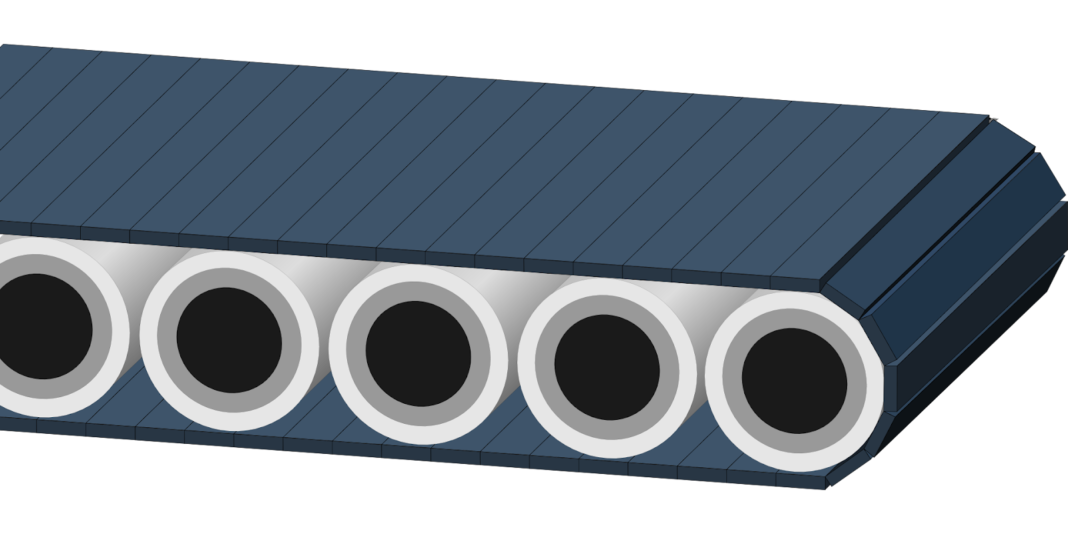If there is one machine that has helped the world move more efficiently, it would be a conveyor belt. Manufacturing conveyor belts seems like a very complicated and technical process. The process can be broken down into several key steps, each necessary to produce top-quality conveyor belts. Here we’ll take you through some of these processes step by step to better understand how conveyor belts are made.
Four primary components that go into the manufacture of conveyors are also outlined below.
What Exactly Makes up Conveyor Belts?
A conveyor belt comprises two essential components: a thick, robust conveyor material and two powered pulleys. Conveyor belts are designed to fulfill standard functions. What product, weight, pace, and industry the belt is ideally suited for are determined by the design and construction of each belt.
Most conveyor belts used today are made of five types of materials. These materials are:
- Metal – Strong and sturdy metal conveyor belts are appropriate for any industry, notably food service and unpackaged commodities. These flat, durable belts are easy to work on. They’re stiff so that they won’t lose shape over time. Due to their inflexibility, conveyor pathways are limited. Metal conveyor belts are aluminum, curved stainless, or carbon steel.
- Fabric – Medium-impact fabric conveyor belts are cost-effective. Gravel, sand, and other bulk materials are regularly transported. Most supermarket checkout lines use fabric conveyor belts. Polyester, Nylon, and Kevlar are also the most common materials used.
- Thermoplastics – Thermoplastic conveyor belts are polymer-made. Flexible and hygienic thermoplastic conveyor belts are perfect for food handling, textile processing, and metal transfers. Thermoplastic belts are similarly lightweight. The National Industrial Belting Association defines a lightweight conveyor belt as having less than 160 lbs/width.
- Rubber – Rubber conveyor belts are common in airports and mines. Flexible rubber conveyor belts are smooth and seamless. They’re also inexpensive.
- Leather – Due to its durability and availability, early conveyor belts were fashioned of leather. Leather is shock-proof and grippy. It is utilized in hybrid and bespoke conveyor belts.
Applications and advantages vary depending on the type of conveyor belt material.
History of Conveyor Belts
Many think the first conveyor belt appeared in the late 1700s or early 1800s, though this is unproven. The first conveyor belts were hand-operated and made of wood and leather. Back then, belts were primarily utilized in agricultural contexts to facilitate product movement. Steam-powered conveyor belts, which eliminated a significant amount of manual work from belt operation, were a product of the Industrial Revolution.
Conveyor belts underwent yet another substantial change in production capability after Charles Goodyear invented vulcanized rubber in 1844. The vulcanized rubber was the best since it was stronger and heat resistant. Conveyor belts debuted in 1902, while underground belts followed in 1905. Conveyor belts first attracted widespread attention in 1913, when Henry Ford made notable use of one in his assembly line. There were numerous developments and changes. The first plastic conveyor belt was introduced in 1970.
The Present
In the modern era, conveyor belts are frequently modified, improved, and rebuilt. The industrial industry keeps developing new ways to improve traditional procedures as technology advances. Belt conveyors are not an exception.
Conveyor belts with smart technology have been adopted by many industries, enabling the belt to “speak” to other components of the manufacturing line. Intelligent conveyor belts are fitted with the capacity to provide alarms during a defect or break down, adjust their speed at pre-programmed intervals and start and stop autonomously. Eco-friendly conveyor belts, such as those driven by solar energy or made from recyclable materials, have become more popular recently.
The Manufacturing Process of Conveyor Belts
The largest conveyor belt producer in the world for mining and industrial uses, Fenner Dunlop, explains how its conveyor belts are made.
Receiving And Twisting Yarn
The production process begins with the yarn being received and twisted together. To make a thread, single yarn strands must first be twisted together. Before passing the yarn through the loom, the twisted portions are wound onto a spindle for storage and to prevent tangling.
Weaving
The following stage involves passing the yarn’s tangled strands through the loom, which binds the strands together. This results in the creation of the fabric belt’s shape and body.
Treating
To provide the fabric belt with a sturdy foundation for the rubber component to attach, the fabric is treated with a specifically designed and unique adhesive in this stage. Heat is delivered through a computerized system to fuse the thread and rubber parts to form a rubber belt.
Calendering
The treated cloth is then delivered to one of Fenner’s production sites. The rubber compounds are disintegrated in the following step of the calendering procedure to apply the fabric carcass.
Laminating
The laminating procedure involves building the conveyor belt. The remnants of the calendered cloth are then run through a laminating stage. The calendered stacks are pressed together to create a conveyor belt.
Conclusion
As the manufacturing of conveyor belts moves forward and the demand increases, so does the need for quality training. This information provided here should assist you in making an informed decision should you be in the market for new belts at your place of business. But always remember that the actual cost of a conveyor belt is often more than the price tag would indicate. With all the different companies manufacturing conveyor belts, it can be hard to tell who and what to trust.















